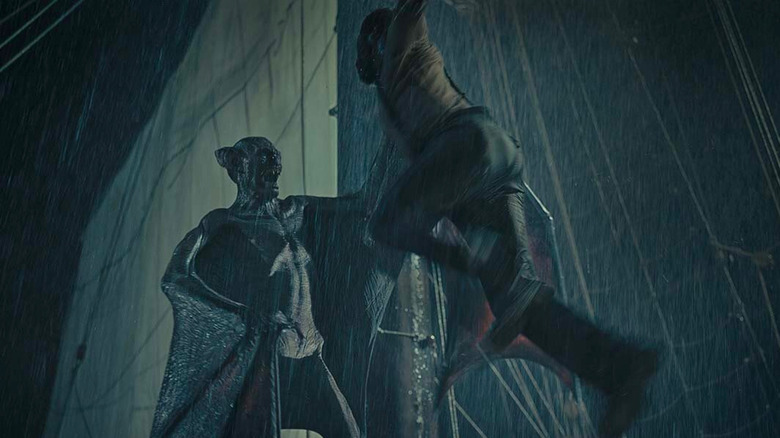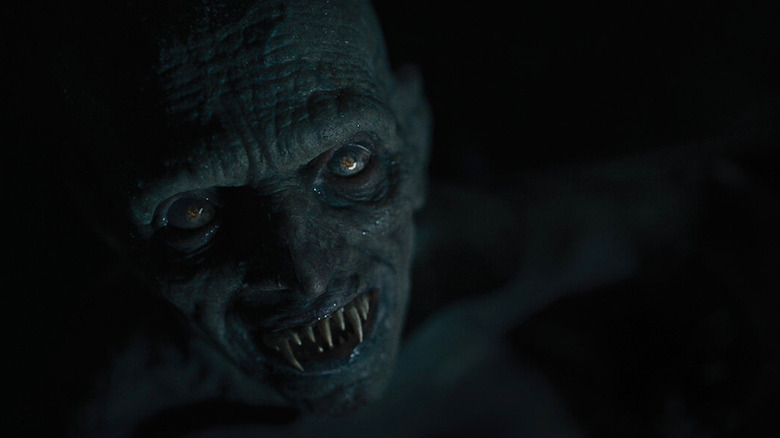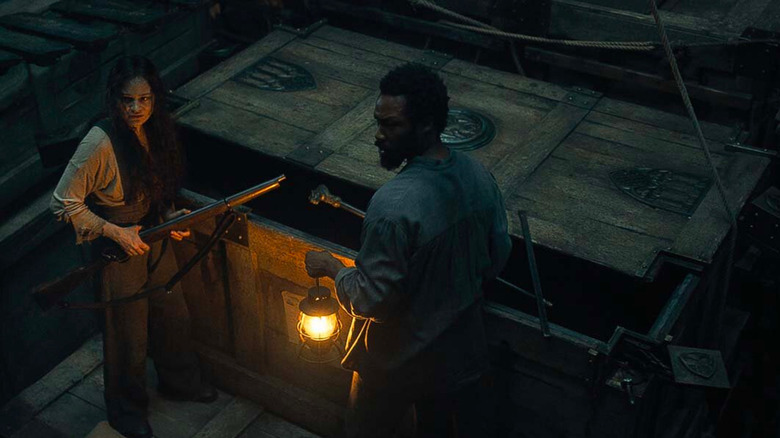The Last Voyage Of The Demeter's Dracula Is The Closest We've Ever Seen To Bram Stoker's Original Monster
What do you think of when you think of Dracula? (Assuming you think about him at all; I know I do.) The vampire Count likely conjures up images of a tux and a cape; a suave, seductive presence who woos virginal women before sinking his fangs into their necks. But here's the thing: the debonair Drac is almost entirely an invention of the movies. In Bram Stoker's novel, Dracula is not a sexy guy who shows up at dinner parties dressed to the nines. He's a malevolent monster lurking in the shadows.
In fact, Dracula himself is barely in the novel that bears his name. After the first several chapters, in which an aged Dracula meets and imprisons Jonathan Harker in his castle, the vampire takes a powder and recedes into the background. Stoker's book is an epistolary novel, which means it's made up of diary entries, letters, and newspaper clippings. As such, much of the book is in the first person, from the point of view of several characters who butt up against the vampire when he makes his way to England. We never get inside Dracula's head, nor do we see him seducing anyone. Instead, he pops up from time to time to wreak havoc and then disappears back into the night.
Which brings us to "The Last Voyage of the Demeter."
A storm rolling in
André Øvredal's horror movie, heavily inspired by "Alien," traps a bunch of people on a boat and proceeds to have Dracula pick them off one by one. This is lifted directly from Stoker's novel, and believe it or not, "Demeter" ends up giving us our most book-accurate take on the Count's monstrousness yet. In the book, Dracula travels from his native Romania to England stowed away in a crate full of his native soil (vampires have to sleep in dirt from their homeland, it's a whole thing). The same thing happens in the film, and while the movie fleshes things out to fill a feature-length runtime, it remains true to the events of the book.
Dracula lays waste to the crew, an animalistic monster who isn't concerned with seducing anyone. He just wants to feed. While the book character is never as monstrous-looking as the Dracula in the movie (played by monster actor extraordinaire Javier Botet), his general countenance makes that of the book perfectly. As in the book, Dracula is a monster. He has no real feelings other than hunger. He's like a plague, or a storm rolling in. Storms have no emotions; they just destroy.
There's no wrong way to portray Dracula
The behavior of Dracula in "Demeter" is also similar to how Dracula operates in the novel — out of the shadows, plotting and killing when he needs to. He even taunts his prey, something the vampire in Stoker's novel does several times whenever he bothers to show up. He's an arrogant immortal; a being who has been around so long that he believes nothing can destroy him. And for the most part, he's kind of right — the poor hapless humans on the ship don't have much of a chance.
To be clear, there's no wrong way to portray Dracula. Like Batman, all versions of the character a valid. If you prefer your Draculas to be smooth and silky and sexy, there are plenty of incarnations out there. But the more monstrous, villainous Dracula is hard to come by in the movies. Hell, "Bram Stoker's Dracula," a film that mostly sticks close to Stoker's novel, turns the count into something of an antihero.
This is why the Dracula in "The Last Voyage of the Demeter" feels so unique. We rarely get to see Dracula go full-monster — Dracula in beast mode, as it were. And to turn him into a literal creature of the night, a demonic presence with no remorse, is to hew closer to the character that Stoker created 126 years ago.


